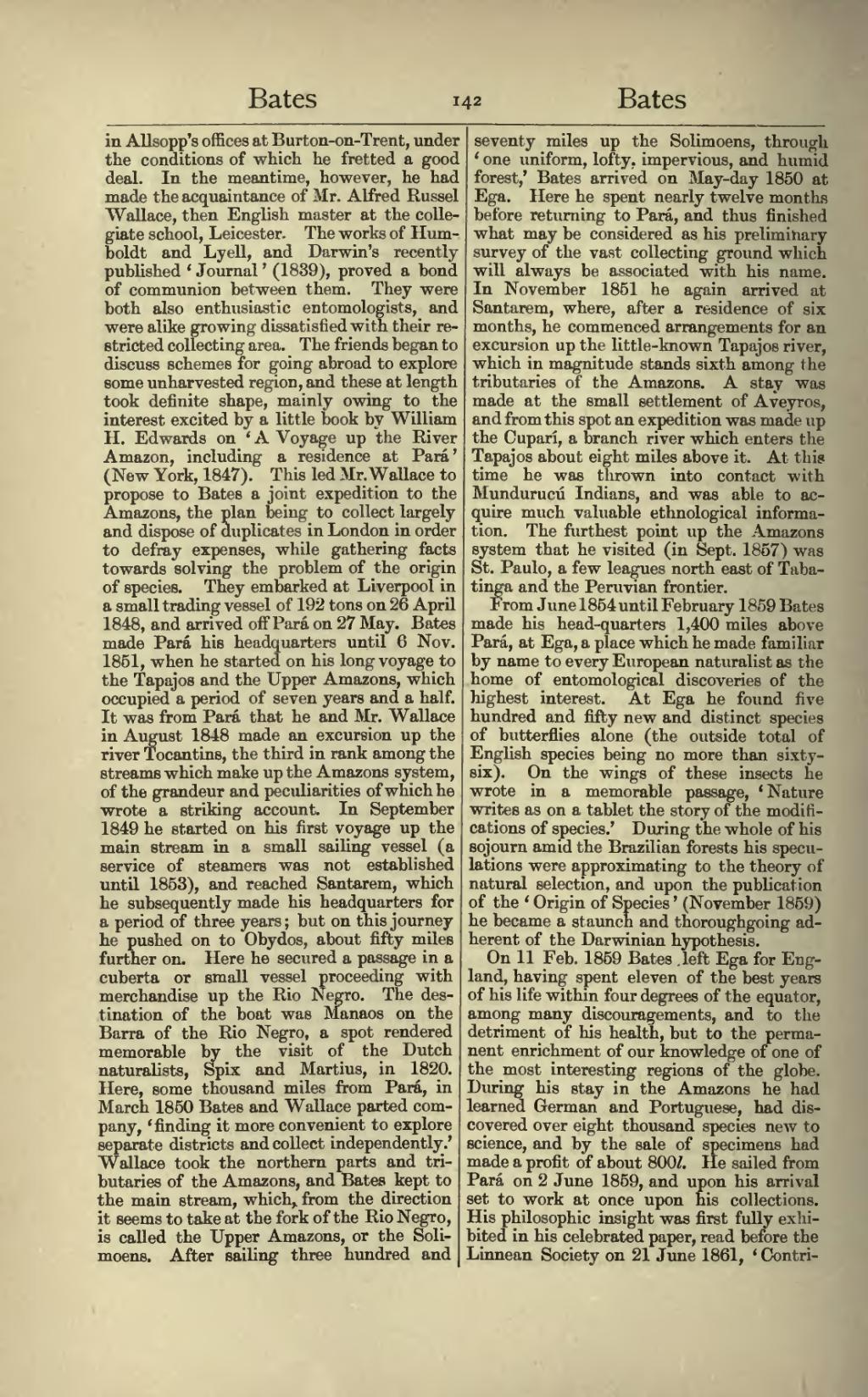in Allsopp's offices at Burton-on-Trent, under the conditions of which be fretted a good deal. In the meantime, however, he had made the acquaintance of Mr. Alfred Russel Wallace, then English master at the collegiate school, Leicester. The works of Humboldt and Lyell, and Darwin's recently published 'Journal' (1839), proved a bond of communion between them. They were both also enthusiastic entomologists, and were alike growing dissatisfied with their restricted collecting area. The friends began to discuss schemes for going abroad to explore some unharvested region, and these at length took definite shape, mainly owing to the interest excited by a little book by William H. Edwards on 'A Voyage up the River Amazon, including a residence at Pará' (New York, 1847). This led Mr. Wallace to propose to Bates a joint expedition to the Amazons, the plan being to collect largely and dispose of duplicates in London in order to defray expenses, while gathering facts towards solving the problem of the origin of species. They embarked at Liverpool in a small trading vessel of 192 tons on 26 April 1848, and arrived off Pará on 27 May. Bates made Pará his headquarters until 6 Nov. 1851, when he started on his long voyage to the Tapajos and the Upper Amazons, which occupied a period of seven years and a half. It was from Pará that he and Mr. Wallace in August 1848 made an excursion up the river Tocantins, the third in rank among the streams which make up the Amazons system, of the grandeur and peculiarities of which he wrote a striking account. In September 1849 he started on his first voyage up the main stream in a small sailing vessel (a service of steamers was not established until 1853), and reached Santarem, which he subsequently made his headquarters for a period of three years; but on this journey he pushed on to Obydos, about fifty miles further on. Here he secured a passage in a cuberta or small vessel proceeding with merchandise up the Rio Negro. The destination of the boat was Manaos on the Barra of the Rio Negro, a spot rendered memorable by the visit of the Dutch naturalists, Spix and Martins, in 1820. Here, some thousand miles from Pará, in March 1850 Bates and Wallace parted company, 'finding it more convenient to explore separate districts and collect independently.' Wallace took the northern parts and tributaries of the Amazons, and Bates kept to the main stream, which, from the direction it seems to take at the fork of the Rio Negro, is called the Upper Amazons, or the Solimoens. After sailing three hundred and seventy miles up the Solimoens, through 'one uniform, lofty, impervious, and humid forest,' Bates arrived on May-day 1850 at Ega. Here he spent nearly twelve months before returning to Pará, and thus finished what may be considered as his preliminary survey of the vast collecting ground which will always be associated with his name. In November 1851 he again arrived at Santarem, where, after a residence of six months, he commenced arrangements for an excursion up the little-known Tapajos river, which in magnitude stands sixth among the tributaries of the Amazons. A stay was made at the small settlement of Aveyros, and from this spot an expedition was made up the Cupari, a branch river which enters the Tapajos about eight miles above it. At this time he was thrown into contact with Mundurucii Indians, and was able to acquire much valuable ethnological information. The furthest point up the Amazons system that he visited (in Sept. 1857) was St. Paulo, a few leagues north east of Tabatinga and the Peruvian frontier.
From June 1864 until February 1859 Bates made his head-quarters 1,400 miles above Pará, at Ega, a place which he made familiar by name to every European naturalist as the home of entomological discoveries of the highest interest. At Ega he found five hundred and fifty new and distinct species of butterflies alone (the outside total of English species being no more than sixty-six). On the wings of these insects he wrote in a memorable passage, 'Nature writes as on a tablet the story of the modifications of species.' During the whole of his sojourn amid the Brazilian forests his speculations were approximating to the theory of natural selection, and upon the publication of the 'Origin of Species' (November 1859) he became a staunch and thoroughgoing adherent of the Darwinian hypothesis.
On 11 Feb. 1859 Bates left Ega for England, having spent eleven of the best years of his life within four degrees of the equator, among many discouragements, and to the detriment of his health, but to the permanent enrichment of our knowledge of one of the most interesting regions of the globe. During his stay in the Amazons he had learned German and Portuguese, had discovered over eight thousand species new to science, and by the sale of specimens had made a profit of about 800l. He sailed from Pará on 2 June 1859, and upon his arrival set to work at once upon his collections. His philosophic insight was first fully exhibited in his celebrated paper, read before the Linnean Society on 21 June 1861, 'Contri-
